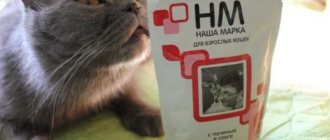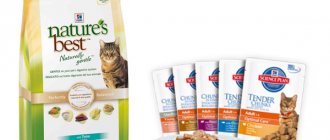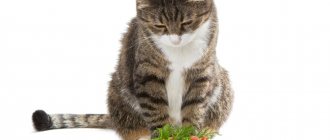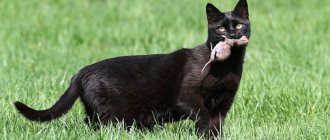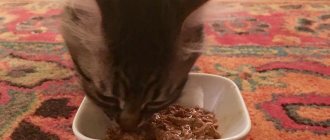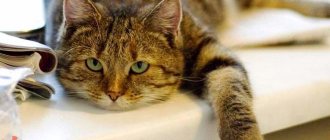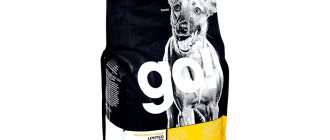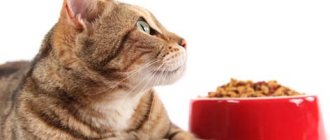April 17, 2018
The idea of producing a special product for dogs first came to businessman James Spratt in the 1860s in England, when he noticed that sailors were feeding their dogs with dry pieces of biscuit left on the ship. The first mixture Spratt developed contained wheat flour, vegetables and beef blood.
The product proved popular, and soon manufacturers began to develop other, more advanced food recipes for dogs and cats, taking into account the need for vitamins and nutrients depending on the age and activity of the animals.
For several decades now, the basic composition of dry food has remained unchanged: meat, grains or other sources of carbohydrates, vegetables, animal fats, vitamins and minerals, preservatives.
Features of dry food production
An important step in the production of dry food was the widespread use of such a technical innovation as an extruder. In fact, the principle of extrusion has been known for a very long time, and its simplest version is an ordinary household meat grinder. But naturally, modern extruders used in the food industry are complex multifunctional machines.
When producing dry food, the nutrient mixture in the form of minced meat is heated to a temperature of 90–150°C and passed through molding holes under high pressure. The result is the same kind of strands that you see when you pass meat through a meat grinder.
Then these bundles are cut, shaped and dried - this is how everyone gets familiar light granules, usually in the form of balls. True, sometimes they are given an attractive color or a funny shape, but this is done solely for the joy of the owners - the animals do not care at all what what they eat looks like.
The main role for them is played by smell, and above all the aroma of meat, because let’s not forget that cats and dogs are predators, and domestication has not changed this fact.
Meat components
The main criterion by which feeds differ from each other is the quality of the raw materials, primarily animal protein sources. High-quality food uses meat and meat by-products (for example, liver or kidneys - what is called “offal” in cooking).
Cheaper feeds use products left over from meat processing plants after the tastiest parts of the carcass have been sent to the shelves in butcher shops - sinew, blood and bones. On labels such ingredients are often referred to as “meat products.”
Why are dehydrates needed?
The extrusion process imposes a number of restrictions on the use of fresh or raw meat in dry food. If there is too much of it, it will not be possible to achieve the desired temperature and high protein content, because fresh raw materials contain a lot of water.
Therefore, in dry food, dehydrated, dried meat is also necessarily used, from which water and part of the animal fats have been removed, resulting in a product with a high protein content. Close to it in its properties is such a common ingredient as meat flour - dried meat, ground into powder.
The most common type of meat for the production of dry food is chicken - an inexpensive and complete source of animal protein. However, manufacturers now offer a wide selection of foods based on turkey, lamb, pork, fish, as well as diets with the addition of meat from such “exotic” species of animals and birds as ostrich, deer or wild boar.
Is it possible to make food with your own hands: 5 stages of preparation
You can make an analogue of dry food at home, but you should not prepare large batches of food. Without the addition of preservatives, drugs that inhibit the growth of molds and bacteria, food cannot be stored for months, like the industrial version.
Meat (fish) food
To prepare you will need:
- Meat – 2 kg. Pork is contraindicated for cats; it is better to take beef, veal, and turkey. Offal products are good (liver, kidneys, lung, heart, cleaned stomachs). You can use sea fish (hake fillet, pollock, capelin, blue whiting, anchovy). It is not advisable to mix meat and fish in one serving; it is permissible to use different varieties of the same type of product.
- Vegetables – 0.5 kg. (carrots, beets, zucchini, broccoli).
- Egg – 3 pcs.
- Olive oil – 3-4 tablespoons.
- Rice (buckwheat) – 0.5 cups of the finished product.
Meat (fish) is separated from the bones, vegetables are washed and peeled. The solid components, the porridge, are passed through a meat grinder twice and crushed with a blender until pureed. Add raw eggs, cottage cheese, butter. Mix thoroughly.
Salt, pepper, spices, onions, and garlic are strictly prohibited from being added to the mixture. On the Internet you can find recipes for producing dry cat food based on canned fish. You should not put them into practice; human food contains spices, salt, and an abundance of fats that are harmful to cats.
Be sure to read:
The best cat foods according to veterinarians for 2021
The baking sheet is greased with vegetable oil or covered with parchment or foil. Using a cake decorating bag, squeeze out sausages 1.5-2 fingers thick over the entire length of the sheet. Dry in the oven over low heat until it becomes breadcrumbs.
The finished sticks are crushed into small pieces. The food is stored in the refrigerator, packaged in bags for daily portions.
Sources of carbohydrates
Unfortunately, it is not possible to make dry food from pure meat without additives. In order for the components to bind to each other, sources of carbohydrates are needed. In the early days of dry food production, wheat or corn was used almost exclusively, but later other sources of carbohydrates appeared in dry food - rice, barley, potatoes or legumes.
Cereals serve as a source of carbohydrates and plant protein and, in some cases, when it comes to whole grains such as brown rice, fiber. Most often, grains are added to feed in the form of flour.
The use of potatoes and legumes is a relatively recent trend associated with changes in people's dietary guidelines, with gluten-free products and avoidance of grains becoming increasingly popular. According to some experts, grain-free foods are no better than regular foods, but if your pet is allergic to wheat or corn, they may be a good substitute.
However, according to scientists, the risk of developing an allergy to cereals is lower than to dairy and meat products. According to research, the most common allergens for dogs are beef, dairy, chicken and wheat. For cats, these are beef, fish and chicken.
What is cat food made from?
Ingredients vary by manufacturer, partially influencing the final price of the product. There is no official classification of food, as well as strict frameworks regulating what type of prepared food belongs.
On the shelves there are:
- Economy (multi-colored granules, bright packaging, the presence of the words “appetizing”, “tasty”, etc. in the name);
- Premium;
- Super premium;
- Ultrapremium;
- Holistic super premium (preventing diseases).
The price difference between the first and last options is significant. It is important to study the composition indicated on the packaging. Selected components do not always guarantee an excellent overall result.
The content of wheat, corn of the best origin does not make cereals suitable food for cats. The main portion of the food should be proteins (rabbit, salmon, lamb, beef), with vegetable fiber in second place.
How to make wet food in bags?
To obtain soft pieces, the manufacturer grinds the components to the required fraction and carefully mixes the powders for uniform distribution. Water, fats, flavors, preservatives, prepared gelatin, and other substances are added to the dry mass.
The composition is passed through an extruder - a barrel equipped with a screw. He mixes the entire composition again, pressing it through the holes of the stencil to create the desired shape. Due to humidity, soft food is susceptible to mold and bacteria attack. To prevent spoilage, it is enriched with inhibitors, and the products are packaged in jars and bags.
Be sure to read:
Proplan or Royal Canin: which food is better for cats, comparison, how to choose the best
What is dry cat food made from?
High-quality food is made from whole meat, fish, vegetables, and is additionally enriched with vitamins, chondroprotectors, prebiotics, and taurine.
They are aimed at age and breed groups of animals, adapted to special parameters: cat pregnancy, lactation, gluten allergy, for castrated (sterilized) pets. They have high nutritional value and cover the daily needs of the animal’s body for useful nutrients.
Cheap analogues are made from lower quality components. Instead of beef, they use chicken, and the vague name of the bird does not make it clear which parts of the carcass were used to make cat food - breast (doubtful) or ground bones, feathers.
They contain starch, gluten, and flour in large quantities.
Cellulose
Fiber is the hard shell of a plant cell, which is not digested in the body, but improves intestinal motility and serves as a breeding ground for the proliferation of friendly microflora. Beetroot is most often used as a source of fiber in feed, but this is not the same table beet that we add to borscht or vinaigrette. We are talking about sugar beet pulp remaining after sugar production; on the label this product is indicated as beet pulp.
Actually, there is practically no sugar left in the pulp, but it contains a lot of fiber, which improves the functioning of the gastrointestinal tract. Many manufacturers add a variety of vegetables and fruits to their products, and they can also serve as an additional source of fiber, although beet pulp is in no way inferior to them in its properties.
Vitamins and minerals
The processed raw materials from which cat food is produced are a source of proteins and carbohydrates. Vitamins and minerals are not preserved after processing, so they are added artificially. The manufacturer describes them:
- by simple enumeration - copper, iron, sodium, zinc, calcium;
- indicating specific substances containing minerals.
The sources of minerals are synthetic additives: iron amino acid complex, zinc polysaccharide complex. It is believed that minerals are better absorbed from such compounds.
Vitamins are also added in the form of artificial substances: cholecalciferol (vitamin D from animal sources), ergocalciferol (vitamin D from plants), riboflavin (vitamin B2), vitamin A, vitamin E, thiamine mononitrate (source of vitamin B1), vitamin B6.
So, behind complex chemical names are hidden artificial analogues of natural components that disappeared from the feed during processing. Amino acids (DL-methionine, L-lysine, DL-tryptophan) are also replaced.
Preservatives
The shelf life of dry pet food is usually 12-18 months. How is it possible to preserve the product for such a long time? On the one hand, temperature treatment of food is already a kind of sterilization; moreover, the development of most bacteria requires a humid environment, and there is very little moisture in dry food - about 8%.
But on the other hand, animal feed contains a large amount of fat, and this is the main problem - over time, as they say in everyday life, fats go rancid, but in scientific terms, they oxidize.
In order to stop the oxidation process, antioxidants are added to the feed - substances that protect fats from the harmful effects of oxygen. Twenty years ago, special chemical compounds were mainly used as antioxidants, but since the early 1990s, natural antioxidants have become increasingly popular.
These include vitamin E (another name for mixed tocopherols) and plant extracts, such as rosemary extract. The effectiveness and safety of these additives has been proven: for example, according to studies, tocopherol mixtures can withstand temperatures of up to 150°C and have a shelf life of about 2 years.
1970s - prescription food
The next major step in the development of feeds was advertising campaigns with so-called “prescription” feeds. The key feature of these foods was that they could be purchased through veterinarians.
The most cunning company that was the first to sell prescription food was Hill's. In 1976, it became a subsidiary of Colgate Palmolive. Prior to this, Colgate's parent company had achieved unprecedented success by selling its toothpastes through dentists. Hill's simply transferred successful experience from one area to another. And I was right.
Buyers readily believed the advertising slogan that pet food is a complex product and its selection is best left to professionals. That is, veterinarians who supposedly know better than anyone exactly what to feed your cat.
Probiotics and prebiotics
Some foods contain probiotics and prebiotics. Probiotics are live microorganisms that improve digestion, normalize intestinal microflora and strengthen the immune system.
Prebiotics are food for beneficial bacteria: not digested in the stomach and upper intestine, they enter the lower intestine and contribute to the development of a balanced microflora. Prebiotics include fiber found in grains and vegetables, as well as inulin.
Using probiotics in dry food is not an easy task, as many microorganisms are unable to survive at extrusion temperatures, but there are also resistant strains. These, for example, include Bacillus subtilis (bacillus hay) and Bacillus licheniformis, which are common in soil.
These microorganisms are especially useful for urban animals, especially cats that never leave the apartment.
Current State of the Animal Feed Industry
Over the past 20 years, the animal feed industry has become increasingly closer to the food industry both in technology and in the quality of ingredients used. Manufacturers are required to publish the true composition of each product, the percentage of main components and their sources; raw materials undergo mandatory quality and safety checks.
Owners are increasingly placing the same high demands on food for their dogs and cats as they do on their own food. Thanks to this, manufacturers are developing new technologies to produce higher quality feed, increasing the percentage of meat in their diets, and using natural preservatives.
At the same time, it is important to remember that the body of dogs and cats is different from the human body, and this must be taken into account when choosing what to feed your pet.
How to distinguish quality food?
Meat should be first on the ingredient list. The preferred by-products are kidneys, heart, stomach, liver, and lungs. Tripe and chicken heads are acceptable in small quantities. Such components are included in super-premium and holistic food categories.
General names such as “Meat”, “Poultry”, “Offal” are not desirable. Under these names, various ingredients may be used, and of questionable quality. If the manufacturer avoids specifics, perhaps he wants to hide something from the consumer.
Extracts instead of the substances themselves in the feed are undesirable. For example, instead of meat, hydrolyzed animal proteins may be included. Often the share of meat ingredients can be no more than 4%, as happens in economy-class feeds. This is very little for predators, and therefore such products are not useful for pets.
Below is a comparison of cat food composition.
